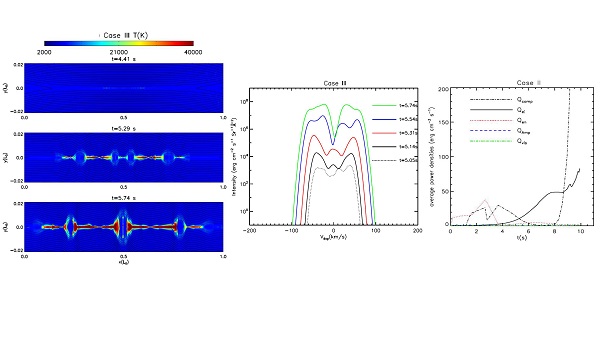Researchers have numerically studied the formation mechanisms of solar ultraviolet bursts based on the optimized magnetohydrodynamics (MHD) code NIRVANA. Their numerical results indicate that the high temperature (~> 20,000 K) solar ultraviolet bursts can be formed in the dense and cool (~5000 K) low solar chromosphere, which have been published in Astronomy & Astrophysics. This work was mainly performed by NI Lei, CHENG Guanchong at the Theoretical Research Group of Solar Activities and CMEs, Yunnan Observatories, Chinese Academy of Sciences (CAS).
Ultraviolet burst is one of the most important discoveries by the Interface Region Imaging Spectrograph (IRIS) satellite. The observational results from multiple wavelengths indicate that magnetic reconnection in the low solar atmosphere is the most important mechanism that triggers the formation of ultraviolet bursts. The previous numerical studies of magnetic reconnection in partially ionized plasmas by Ni Lei et al. 2015, 2016, 2018 have proved this point. However, the low solar atmosphere is highly density stratified. The plasma environments, reconnection mechanisms, radiative cooling and transfer processes clearly differ from one layer of the atmosphere to the next. It is still not clear whether ultraviolet bursts can be generated in the much denser and cooler low chromosphere.
In this work, the researchers studied the low β magnetic reconnection process in the low chromosphere by including the more realistic radiative cooling model, the time dependent ionization degrees of Hydrogen and Helium, which result in the more realistic magnetic diffusion caused by electron-neutral collision and the ambipolar diffusion caused by the decoupling of ions and neutrals.
The numerical results indicate that the plasmas in the reconnection region are heated up to more than 20, 000 K if the reconnecting magnetic field is as strong as 500 G, which suggests that UV bursts can be generated in the dense low chromosphere. The dominant mechanism for producing the UV burst in the low chromosphere is heating, as a result of the local compression in the reconnection process. The thermal energy occurring in the reconnection region rapidly increases after the turbulent reconnection mediated by plasmoids is invoked. The average power density of the generated thermal energy in the reconnection region can reach over 1000 erg cm-3 s-1 , which is comparable to the average power density accounting for a UV burst. With the strength of the reconnecting magnetic field exceeding 900 G, the width of the synthesized Si IV 1394 Å line profile with multiple peaks can reach up to 100 km s-1, which is consistent with observations.
This research is supported by the National Natural Science Foundation of China, the outstanding member of the Youth Innovation Promotion Association CAS program, the Yunling Talent Project for the Youth, the Yunnan Province Scientist Workshop of Solar Physics, Yunnan Key Laboratory of Solar Physics and Space Exploration.
Contact:
NI Lei
Yunnan Observatories, CAS
Email: leini@ynao.ac.cn

The left panel shows the temperature distributions at three different times (900G), the middle panel shows the synthesized Si IV spectral line profiles at five different times after the plasmoid instability appears (900G), the right panel shows the time evolutions of different average power densities which contribute to heating (500G, Qcomp represents the local compression heating mechanism).